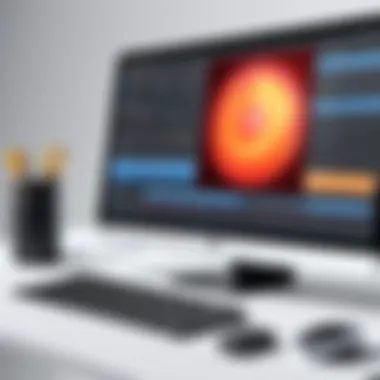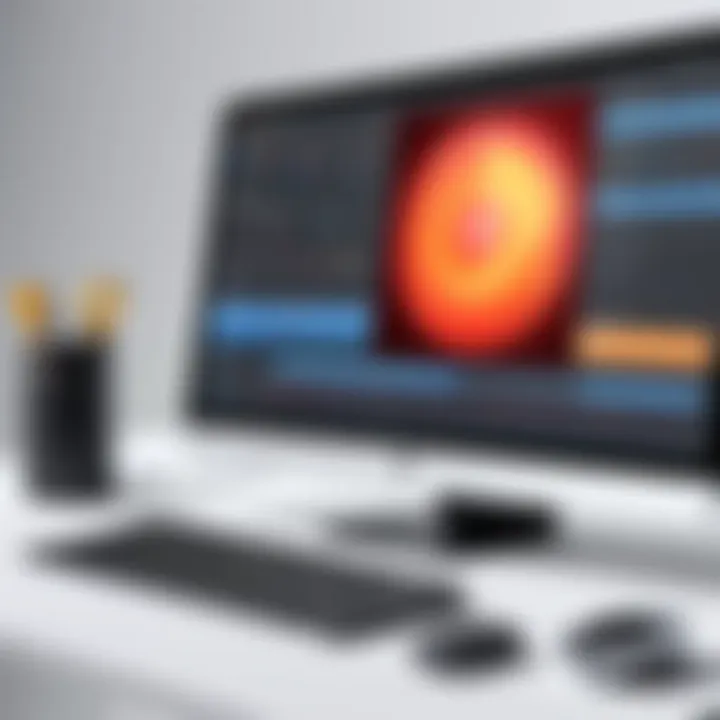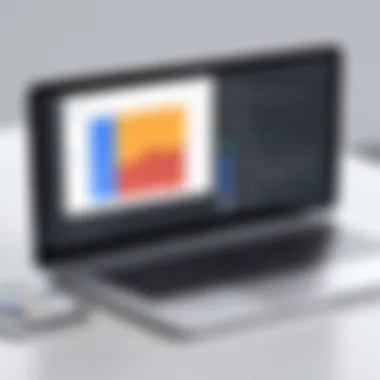Comprehensive Guide to Screen Recording Extensions


Intro
In the digital age, screen recording has become an essential tool for communication, education, and content creation. As professionals and learners alike seek efficient ways to convey information visually, the demand for screen recording solutions increases. Google Chrome, with its extensive library of extensions, offers several screen recording tools that suit a variety of needs and preferences. This article aims to dissect these tools, highlighting their functionalities, strengths, and potential weaknesses.
The accessibility and integration of these extensions within the Chrome ecosystem empower users to create videos in a flexible manner. Whether for tutorials, presentations, or casual sharing, screen recording extensions can significantly enhance digital communication. In this exploration, we aim to present an in-depth understanding of these tools, helping users select the most appropriate ones for their goals.
Prolusion to Screen Recording Technologies
Screen recording technologies have gained significant traction in various fields of communication and content creation. Their ability to capture visual and audio information from a user's screen has transformed how we collaborate, teach, and promote services. This section sets the stage for understanding the fundamental role of screen recording tools, specifically focusing on Google Chrome extensions.
The relevance of screen recording extends beyond mere convenience; they serve as a bridge in effective communication. This technology allows users to convey ideas visually, which often enhances clarity and retention. From business meetings to academic sessions, screen recording tools provide an edge in delivering intricate information efficiently.
Definition and Overview
Screen recording is the process of capturing video output displayed on a computer screen, complemented by audio input, either from a microphone or system sounds. This functionality allows users to document their actions, tutorials, or presentations in real-time. In the context of Google Chrome, screen recording extensions utilize the browser's capabilities to facilitate easy and quick recordings that can be shared or stored for later use.
These tools vary widely in features and ease of use. Some extensions offer basic recording functionalities, while others include advanced features like video editing, annotation, and cloud storage integration. This diversity caters to different users, ranging from educators to marketers, ensuring that everyone can find a suitable solution for their specific needs.
History of Screen Recording Tools
The evolution of screen recording tools began in the late 1980s with the development of software that aimed at capturing screen activities for training and educational purposes. Early tools were often bulky and complicated, limiting their adoption. However, as technology progressed through the 1990s and 2000s, user needs led to the development of more refined applications with improved usability and features.
As the internet became more prevalent, screen recording tools gradually embedded themselves into online learning and content creation. The introduction of Firefox and Google Chrome sparked a new wave of browser-based extensions, simplifying installation and usage. This shift enabled users to access powerful screen recording tools directly from their browsers, streamlining the process.
Thus, screen recording tools have come a long way from their initial concepts, now enriching digital communication through enhanced visual documentation.
Importance of Screen Recording in Communication
Screen recording plays a critical role in modern communication, particularly in the digital landscape. The transformation of interaction to a largely virtual format emphasizes the need for tools that can enhance clarity and understanding. Additionally, screen recording Google extensions address various needs in professional and educational communication.
Enhancing Collaboration
Screen recording tools facilitate meaningful collaboration across teams, regardless of geographic locations. When team members can share their screens, it becomes easier to demonstrate complex processes or share visual information effectively. For instance, a developer can record a walkthrough of software features, which may be especially helpful for non-technical stakeholders. This direct visualization reduces miscommunication, fostering a more productive exchange of ideas and information.
Collaboration through screen recording allows for real-time feedback. Users can make comments or ask questions directly on the recorded footage. This interactive element encourages engagement and ensures that all parties are on the same page. The ability to replay shared content can also serve as a reference point in future discussions.
Educational Applications
In educational settings, screen recording extensions offer significant advantages. Teachers leverage these tools to create instructional videos or tutorials. Students benefit by revisiting lessons at their own pace, enhancing understanding of complex subjects. Moreover, screen recordings can capture step-by-step processes, which proves useful in diverse fields, from coding to graphic design.
The use of screen recordings in education promotes an engaging learning experience. It allows for differentiated instruction, catering to varied learning styles. For instance, visual learners particularly benefit from recorded visual demonstrations. Furthermore, many screen recording tools also support the inclusion of annotations or voice-over, which can clarify explanations and reinforce learning objectives.
Content Creation and Marketing
Content creators and marketers have increasingly recognized the value of screen recording in strategy development. These extensions provide a straightforward means to produce engaging video content. Brands can create how-to videos, product demonstrations, or webinars, all of which can drive higher user engagement. The visual nature of video can lead to increased retention of information compared to text-based content alone.
The integration of screen recordings into marketing strategies can enhance brand visibility. By showcasing products in action, companies can effectively illustrate their value propositions. Additionally, screen recording tools often allow direct sharing to social media platforms, increasing reach and potential customer interaction.
Screen recording tools empower both individuals and organizations to communicate more effectively in various contexts. Their ability to provide clarity, support learning, and enhance content strategies makes them indispensable in today’s digital communication landscape.
Overview of Google Chrome Extensions
In today's digital landscape, Google Chrome extensions represent crucial tools that improve user experience, functionality, and efficiency. These small software programs allow users to tailor their browser experience, bridging gaps between simple web browsing and more advanced tasks.
What Are Chrome Extensions?


Chrome extensions are lightweight applications that expand the capabilities of the Google Chrome browser. They can be installed easily from the Chrome Web Store. Once added, extensions integrate into the existing browser interface, allowing users to perform specific functions without needing to navigate away from their current task. This seamless integration facilitates various activities ranging from productivity enhancements to content management.
Users can install a variety of extensions, including those for screen recording, ad blocking, and productivity tracking. The appeal lies in their ease of use and the significant impact on improving browsing experience.
Benefits of Using Extensions
Utilizing Chrome extensions offers multiple advantages that enhance the overall web experience. Some key benefits include:
- Increased Productivity: Extensions like screen recorders can save time by enabling users to showcase their work or provide feedback directly through recorded video.
- Customization: Users can tailor their browser with tools that fit their individual needs. This level of personalization is not easily achieved with standard browsers.
- Accessibility of Features: Many extensions bring advanced features to users who may not have technical expertise. For example, screen recording can be done without complex software installations.
- Integration with Other Tools: Extensions often sync with other software or cloud services, streamlining workflows and enhancing functionality.
- Community Support: Many popular extensions have active user communities on platforms like Reddit, where users share experiences, tips, and troubleshooting advice.
These points emphasize the importance of understanding and effectively utilizing Google Chrome extensions as they can vastly improve both individual and team productivity. As we explore specific screen recording extensions, understanding the foundation of Chrome extensions will enhance the reader's comprehension of their diverse capabilities.
Popular Screen Recording Extensions on Chrome
Screen recording extensions for Chrome are more than just tools; they are essential assets for anyone engaged in digital communication and content creation. These extensions have revolutionized how users capture, share, and collaborate on information. In a world increasingly reliant on video content, understanding these extensions becomes vital for efficient communication.
One of the primary benefits of screen recording extensions is their versatility. They allow users to create tutorials, record presentations, and even capture gameplay. These are just a few examples of how screen recording tools can enhance productivity. Adaptability to various scenarios is a key factor that contributes to the growing popularity of these tools among professionals and educators alike.
When selecting a screen recording extension, users should consider factors such as ease of use, recording quality, editing features, and integrations with other tools. Additional aspects, like storage options and customer support, may also influence the choice of extension. Ensuring that the selected extension aligns with specific needs is crucial for maximizing its potential.
"The effectiveness of communication often stems from clarity, which screen recording extensions can significantly enhance."
The following sections will delve into some of the leading screen recording extensions available for Chrome: TechSmith Capture, Loom, Screencastify, Nimbus Screenshot, and Awesome Screenshot. Each extension brings unique features and benefits to the table, making them worth examining.
Delving into each of these tools will provide greater insight into their individual capabilities and weaknesses, enabling users to make informed decisions that meet their specific needs.
Features of Effective Screen Recording Extensions
Screen recording extensions for Google Chrome have grown in popularity, serving a variety of needs from education to content creation. In this section, we delve into the critical features that define effective screen recording tools. A good screen recording tool can mean the difference between a clear, informative video and a frustrating experience for the viewer. Therefore, understanding these features is essential for tech-savvy individuals seeking to optimize their digital communication.
Quality of Output
The quality of the output serves as a foundational element for any screen recording extension. Users expect high-resolution recordings without lag or distortion. A good tool should support various resolutions, ideally accommodating up to 1080p or even 4K, depending on the hardware capabilities. Additionally, it should handle different video formats efficiently, allowing users to choose between formats like MP4 or WEBM based on their needs.
Many users overlook the importance of audio quality. Clear, synchronized audio ensures that the message conveyed in the recording is received without misunderstandings. Thus, extensions should also feature high-quality audio recording options, potentially with settings for noise reduction or enhancement of sound clarity.
Editing Capabilities
Editing capabilities significantly enhance the value of a screen recording extension. A tool that only captures video may not meet all user needs. Basic editing features—such as trimming, cropping, and merging clips—are crucial. Ideal extensions allow users to make these adjustments seamlessly.
More advanced editing tools can offer functionalities like adding annotations, call-outs, or highlights to emphasize critical areas in the video. This can be particularly useful in educational contexts, where reinforcing key concepts or steps adds value to the content.
Additionally, the inclusion of effects, transitions, and the ability to insert background music or voiceovers can elevate the final product, making it more engaging for audiences.
Integration with Other Tools
Integration capacity is another pivotal feature when evaluating screen recording extensions. Users often need to use multiple tools in conjunction with their recordings, whether for project management, cloud storage, or content sharing. Extensions that offer direct integration with platforms like Google Drive, Dropbox, or various project management tools can streamline workflows significantly.
Furthermore, compatibility with video conferencing tools can enhance collaborative efforts. If an extension can directly link with applications like Zoom or Microsoft Teams, it allows for an efficient sharing process afterward. This capability is essential in today’s remote work environment where rapid information sharing is crucial.
Limitations of Screen Recording Google Extensions
Screen recording Google extensions come with significant benefits, yet they also harbor notable limitations. Understanding these constraints is crucial for users who aim to maximize their screen recording endeavors. This section will explore common limitations that could influence how effectively one can use these tools for different purposes.
Performance Constraints
Performance constraints are a primary concern for those using screen recording extensions. Depending on the device's hardware specifications, different users may experience varied performance levels.


- Processing Power: The CPU and RAM of a device play a significant role in its ability to handle simultaneous processes. Users with older or less powerful devices may find that the extension affects overall system performance, leading to lag or diminished recording quality.
- Video Quality: High-resolution recordings demand greater processing capabilities. If the device cannot support higher resolutions, users might have to settle for lower-quality recordings.
- Impact on Other Applications: Running a screen recording extension can utilize substantial system resources. As a result, other applications may struggle to function smoothly. This can be a particularly pressing issue in environments requiring multitasking or resource-intensive applications.
Dependency on Internet Connection
Internet connectivity is another critical factor for screen recording extensions. Many of these tools integrate cloud features for video storage and sharing, making them reliant on a stable internet connection.
- Upload Speed: Users with slower upload speeds will experience longer delays when saving or sharing recorded content. This can affect workflow and productivity, particularly for professionals needing to disseminate information quickly.
- Latency Issues: A poor internet connection may also lead to latency during live recordings. This can create sync issues between audio and video, compromising the effectiveness of the material produced.
- Offline Functionality: While some extensions offer the ability to record without an internet connection, users may discover that options are limited, preventing them from accessing full features when offline.
Privacy and Security Concerns
Privacy and security are paramount in today’s digital landscape. While many screen recording extensions are designed with security features in mind, users must remain vigilant about potential risks.
- Data Collection: Some extensions may collect user data, raising questions about privacy. Users should thoroughly read the privacy policy of any extension to understand how their data may be used or shared.
- Malicious Software: Not all screen recording tools are created equal. Users need to be cautious about downloading extensions from unverified sources, as they may carry malware or spyware risks.
- Unintended Sharing: Depending on the configuration, it’s possible for users to unintentionally share sensitive information during a recording. This risk necessitates careful consideration of what is being recorded and shared.
The limitations of screen recording extensions must be acknowledged to make informed decisions when choosing the right tool for specific needs. This understanding can help users avoid potential pitfalls and select solutions that fit their requirements better.
In summary, while screen recording extensions offer remarkable capabilities, their limitations—performance constraints, dependency on internet connectivity, and privacy concerns—serve as important considerations for any potential user. Recognizing these factors helps individuals and organizations make more educated choices.
Comparative Analysis of Leading Extensions
In the realm of screen recording Google extensions, performing a comparative analysis is fundamental. This section allows users to weigh the strengths and weaknesses of various extensions, helping them make informed decisions. When selecting a screen recording tool, considerations such as user experience, functionality, and specific use cases are vital. Users may have different needs based on whether they are creating tutorials, recording presentations, or sharing moments online. Each extension offers unique features that cater to distinct purposes. Thus, understanding these differences is imperative.
TechSmith Capture vs Loom
TechSmith Capture and Loom stand out in the competitive landscape of screen recording tools. TechSmith Capture delivers robust functionality, appealing to educators and professionals alike. It supports annotation, enabling users to highlight important points during recordings. Moreover, its integration with TechSmith’s other products, like Camtasia, makes it a choice for those seeking comprehensive editing features. This extension aims to provide a seamless workflow for users who require both recording and advanced editing capabilities.
Loom, on the other hand, emphasizes simplicity and immediacy. It appeals to users looking for quick sharing options, such as video messaging in workplace communications. Loom also allows real-time viewer insights, which can guide content creators in understanding engagement. For users who favor speed over extensive features, Loom is an ideal choice.
Ultimately, the decision between TechSmith Capture and Loom should revolve around the user’s needs. If depth and editing are priorities, TechSmith Capture may be preferable. If instantaneous sharing and collaboration are key, Loom might be more suitable.
Screencastify vs Nimbus Screenshot
When comparing Screencastify and Nimbus Screenshot, it becomes evident that both extensions serve unique purposes. Screencastify excels in its ease of use and versatile functionality. This extension allows recordings up to 50 mb and integrates with Google Drive, making it convenient for users who rely on cloud storage. Moreover, Screencastify facilitates a quick response for educators and businesses, providing a straightforward way to create lessons or presentations without extensive technical knowledge.
Conversely, Nimbus Screenshot offers a comprehensive toolkit that extends beyond mere screen recording. It enables users to capture screenshots, annotate them, and turn recordings into GIFs. This multifunctionality is particularly beneficial for users who require a blend of capabilities, such as marketers or project managers. The ability to customize content adds significant value.
Choosing between Screencastify and Nimbus Screenshot ultimately depends on user requirements. Those needing basic recording functionality may find Screencastify sufficient, while users looking for a varied toolkit might prefer Nimbus Screenshot.
Overall Functionality Assessment
Overall, the functionality of each extension can significantly influence user satisfaction. These assessments should cover a range of factors, such as ease of use, available features, and integration potential. Users must consider their specific application of the tools—different contexts require different functionalities. Also, the interface simplicity can impact overall user experience, especially for non-technical individuals.
Regular updates and support are also essential considerations. Extensions that have proactive development and customer service tend to offer longer-lasting value. Thus, evaluating these aspects when analyzing screen recording Google extensions greatly enhances user knowledge and experience.
"An informed decision leads to better productivity and satisfaction when it comes to selecting screen recording tools."
By examining these key comparisons, users can better navigate the diverse landscape of screen recording extensions, ultimately selecting one that aligns most closely with their needs.
Best Practices for Screen Recording
Effective screen recording is essential for ensuring that you not only capture high-quality content but also communicate it clearly to your audience. Whether you are producing educational material, tutorials, or presentations, following best practices can greatly enhance the final output. It sets a solid foundation, promotes engagement, and ensures understanding. Without proper preparation and techniques, even the best screen recording tools may not yield the desired impact.
Preparation Before Recording
Preparation is the cornerstone of any recording session. Taking time to plan can save significant effort during the editing process and greatly improve the clarity of your content.


- Define Your Objectives: Start by knowing what you want to achieve. Ask yourself questions such as what topics you want to address and the key points that need emphasis.
- Script Your Content: Writing a script or an outline can provide structure and ensure that you stay on topic. This can help avoid unnecessary ramblings, making your recording more efficient.
- Test Your Equipment: Verify that your microphone, camera, and any software tools are functional before starting the recording. This can prevent interruptions due to technical issues.
- Adjust Settings: Ensure that your recording settings are optimized for quality. This might include frame rate, resolution, and audio levels.
- Choose the Right Environment: Record in a quiet place with minimal distractions. A pleasant background can also contribute positively to the viewer's experience.
Before hitting the record button, a bit of preparation goes a long way.
Techniques for Clear Communication
Once the recording begins, clear communication becomes critical. The effectiveness of your message largely depends on how well you convey it.
- Speak Clearly: Enunciate your words and maintain an appropriate pace. Speaking too fast can confuse the audience, while speaking too slow could lose their attention.
- Use Visual Aids: Incorporating diagrams, annotations, or bullet points can enhance understanding. The use of on-screen text can reinforce the verbal message.
- Engage the Audience: Although direct interaction is limited in screen recordings, asking rhetorical questions can engage viewers. This method provokes thought and maintains interest.
- Maintain Focus: Stick to the main topics. If you stray, it might confuse your audience.
- Feedback Loop: If possible, get opinions from test viewers. This will help refine your approach and increase the quality of the final product.
Implementing these techniques will elevate your capability to communicate effectively through recorded media.
Editing and Post-Production Tips
Editing is where the essence of your content truly shines. A good editing process refines the recording to make it more polished and engaging.
- Review Your Footage: Watch the entire recording to identify areas that require trimming or adjustment. Look for mistakes or points that need improvement.
- Use Editing Software: Leverage software like Adobe Premiere Pro or Camtasia for comprehensive editing options. This allows added features such as transitions, effects, and adjustments to audio levels.
- Add Captions: Including captions increases accessibility. This helps viewers who may be listening in a noisy environment or have hearing impairments.
- Optimize Length: Aim for conciseness. Viewers often have short attention spans. Remove any segments that do not contribute to the main points.
- Finalize with a Call to Action: For content aimed at driving engagement, ending with a clear call to action can encourage viewers to act on your suggestions or feedback.
Investing effort into editing can tremendously enhance the viewer's experience and comprehension.
Engaging in these best practices ensures that your screen recordings are not just visually captivating but also effectively communicate your message.
The Future of Screen Recording Technologies
The realm of screen recording technologies is evolving at a significant pace. This evolution is driven by advancements in software, user demands, and the increasing importance of visual communication. As more individuals and organizations recognize the value of effective screen recording, the development of extensions will play a crucial role in meeting diverse needs. Looking ahead, several key elements will shape the future of screen recording tools.
Understanding these trends and advancements will help users make informed choices about their screen recording practices.
Trends in Screen Recording Extensions
Several emerging trends are defining the future of screen recording extensions. These trends reflect both technological advancements and shifts in user behavior.
- Increased Integration with Collaboration Tools: As remote work becomes more common, screen recording extensions will increasingly integrate with platforms such as Google Workspace and Microsoft Teams. This integration allows for seamless sharing of recorded content directly within collaborative environments.
- Artificial Intelligence Enhancements: The incorporation of AI will revolutionize how screen recording extensions function. Features like automatic transcription and intelligent editing suggestions will streamline the post-production process. AI can analyze recording content and suggest the best highlights, making it easier for users to create concise and impactful videos.
- Focus on User Experience: There will be a greater emphasis placed on user-friendly interfaces. As user bases grow, developers will prioritize intuitive designs that cater to all skill levels. Streamlined workflows will facilitate faster recording and easier access to editing tools.
- Mobile and Cross-Platform Compatibility: With the increasing importance of mobile technology, screen recording extensions will find ways to be more flexible across different devices. Users crave accessibility, so extensions will likely expand beyond Chrome to offer functionality on mobile devices and other popular web browsers.
These trends indicate that screen recording is no longer just about capturing what’s on a screen. It’s expanding into a robust tool for collaboration, education, and content creation.
Advancements in Technology and User Experience
The technological advancements in screen recording extensions are pushing the boundaries of what is possible. Here are a few key areas where significant progress is being made:
- Improved Recording Quality: With the advent of high-definition recordings, screen recording extensions are now able to capture crisp and clear visuals. This is essential for creating professional-quality content.
- Enhanced Editing Features: Future screen recording extensions will likely come equipped with sophisticated editing tools that allow users to modify their recordings easily. Features such as trimming, annotations, and visual effects will help users produce polished final products with minimal effort.
- Real-Time Collaboration Features: Innovations in real-time collaboration will permit users to work together during the recording process. This feature can be crucial for teams conducting joint presentations or educational tutorials.
- Streamlined Sharing Options: With an increase in content sharing demands, future extensions will likely offer simplified sharing mechanisms. Users may be able to publish their recordings directly to popular social media platforms or embed them into websites without leaving the extension interface.
"The impact of screen recording goes beyond mere capture; it’s a vital medium for expression, learning, and collaboration in a digitized world."
Embracing these trends and advancements ensures that your screen recording efforts yield maximum benefit.
Ending
In this article, we have explored the nuances of screen recording Google extensions and their impact on digital communication and content creation. The significance of this topic cannot be understated, as screen recording tools empower users to create visually engaging content that enhances understanding and collaboration. By summarizing key points and providing practical recommendations, the closing section serves to reinforce how these tools can significantly benefit users, whether they are educators, marketers, or casual creators.
Summarizing Key Points
To encapsulate the discussion, here are the primary facets covered:
- Definition: Screen recording extensions are software add-ons designed to capture the on-screen activity of users in real-time.
- Importance: The ability to communicate ideas clearly and efficiently is enhanced with the use of these tools.
- Popular Extensions: We examined notable options like TechSmith Capture, Loom, and Screencastify, each with unique features tailored to user needs.
- Limitations: The analysis of performance constraints and privacy concerns raised crucial considerations for potential users.
- Best Practices: Preparation before recording, techniques for effective communication, and post-production tips were highlighted to optimize user experience.
Recommendations for Users
When selecting a screen recording extension, users should consider several factors to ensure they choose the right tool:
- Identify Needs: Assess what you need from the tool. Is it for teaching, marketing, or personal use?
- Test Various Options: Most extensions offer trial periods. Take advantage of these to find what best suits your workflow.
- Evaluate Features: Look for specific features that align with your goals, such as editing capabilities and formats supported.
- Check Integration: Ensure the chosen extension can integrate seamlessly with other software and tools you already use.
- Stay Informed: Technology evolves quickly. Keep up with new releases or updates to existing extensions.
Ultimately, screen recording extensions are valuable assets in the realm of digital communication. Selecting the right one tailored to specific needs can lead to enhanced productivity and creativity.







